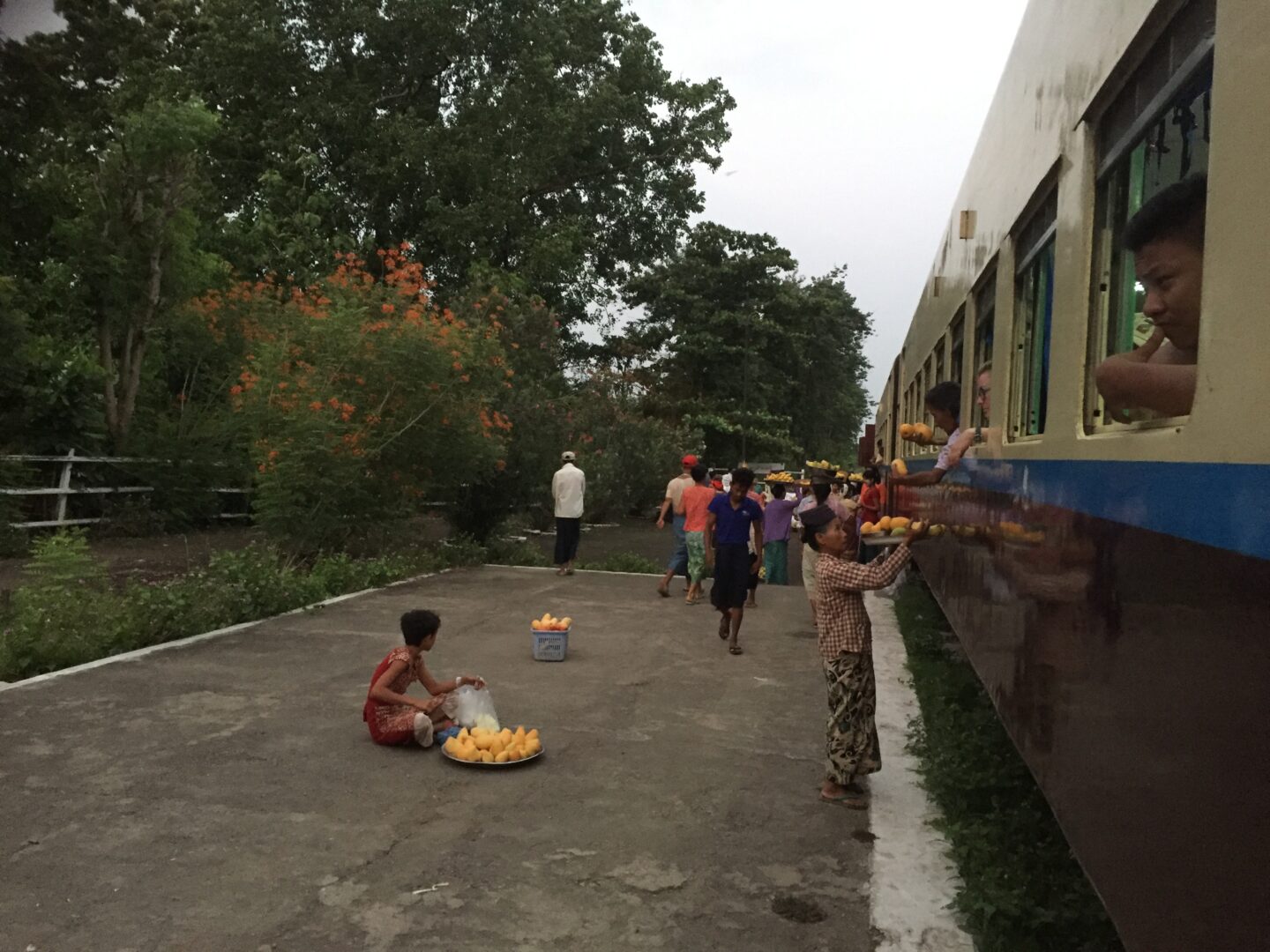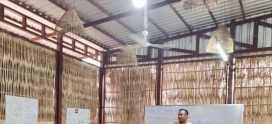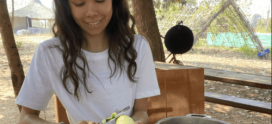Week 9 in Myanmar
Week 9….or 10 – have forgotten
It’s been a busy week in many ways. However, underpinning every activity is preparing for the ever-present humidity of over 90% and the occasional dump of what seems like half the Indian ocean in a couple of hours. Now, this is where the umbrella performs its second important function, which is to protect its handler from a drenching: so, it’s a recent and essential purchase for me.
Meantime, every activity not performed under a well-positioned air conditioning unit results in a reflex desire for a cold shower. This is fine if the water pressure is sufficient in the flat; alas, not always the case. The rains have come early I am informed and looking at the forecast for the next three weeks, there is going to be no let-up for Yangon.So, added to the early morning i-phone alarm, there is the singing cockerel, the wailing cats, and now the torrential rain battering the corrugated iron roof over the flat.
But, although I sometimes lament ‘England’s pastures green’, the week has seen an exciting marriage of new experiences, visits to places of immense beauty or historical interest, and further examples of the challenge to doctoring here as we know it in the West.
The pig has been the unfortunate number-one hit for the carnivorous minded for several blogs now, so it was with interest when I went on a neurology ward round yesterday to see the consequences of the intimate relationship between man and this beast.
Now, I have a bed ring-fenced and warmed in my old ID Unit for my hepatitis E but hopefully I’ll avoid cysticercosis, Japanese B encephalitis, and meningitis due to streptococcus suis: all pig-related afflictions and all present on the ward. Interestingly, in Myanmar Strep. Suis meningitis is rarely found despite being the commonest cause of meningitis a few blocks away in Vietnam and pig on the stick being the equivalent of a KFC chicken nugget here.
On this ward round, I witnessed the frustrating restrictions placed on the fantastic neurologists (only emergency CT scans are free – everything else depends on the depth of the family coffers), so their success in saving brains and lives is even more remarkable. For example, although encephalitis is a common diagnosis, a confirmatory CSF herpes simplex PCR, MR scan, or potentially life-saving IV acyclovir are a no-no without deep family pockets. Such is life here.
On the brighter personal side, as an old man who likes a bit of home-grown colonial architecture, the century old Yangon General Hospital with its tiled floors, red-brick arched windows, and evidence of the legacy of pre-antibiotic therapy in the openable sanatorium-like shutters is a time-capsule to a world long past. However, it is no antidote to the overcrowded wards with patient spill-over to every available corridor and the patients no different to the clinic this week with TB meningitis, cryptococcal meningitis, and toxoplasmosis pre-eminent (picture).
Now, I realise that for 3 of my 5 family readers where medicine does not float their personal boats, the paragraph above is to be sped-read and they will skip to my continued personal OAP narrative of Burmese life. Stepping off the plane, it is refreshing as an old man not to have to walk through the last-minute duty free to prompt you to buy a bottle of perfume for your loved one as part of the bribery package for your absence and to regain a few brownie points. Instead, in the arrivals lounge you will immediately see women wearing yellow thanaka powder on their cheeks which is used as a sunblock, skin cleanser, and anti-ageing cream (not sold on the duty-free aisles unsurprisingly). Moreover, on the drive from the airport you will see numerous gold-topped pagodas, and depending on the time you arrive, the orderly processions of monks from boys to old men in their maroon cloaks walking barefoot with alms bowls in hands.
Over 80% of the country are Buddhists and all boys at some point after their 7th birthday spend time in a monastery. Maybe this explains the Burmese folk’s kindness and honesty (just left my mobile phone at a temple which I realised when I was sipping my beer and doing the (easy) Times crossword – my one luxury – a couple of hours later. But no worries, it had been retrieved and was awaiting my return.)
Travelling as everyone else does is one of the most necessary and rewarding experiences in Myanmar. Whether it be the madly dangerous high-speed right hand drive overnight buses which I’ve waxed lyrical about before, the joint-displacing tuk-tuk’s, the circa 1920 colonial trains where it’s not HS2 but HS 0.0001 but refreshingly there’s no forking out an extortionate £200 for a first-class ticket for a 2-hour journey say from Manchester to London. No it’s a mere 1200 Kyat (which is around 75p although the ticket has to be bought at the station and is written out by hand) for a journey that takes twice as long in very roomy ‘upper class’. Admittedly, there’s no cooked breakfast being brought to your table but mangos are proffered through the window at every stop at a very reasonable 10p a shot (picture). Finally, and common for Mandalay, is the no-nonsense, no-headlights, no-helmets, no hand-signals motorcycle taxi with speed-merchant driver. The experience is refreshing but makes you reconsider whether you should have taken out more life assurance cover for your family to benefit from should you never return. No problem when you’re travelling by train, nevertheless, as part of the cost of the ticket includes life insurance: slightly disconcerting! Not certain if British rail offer that?
When in Mandalay, one destination I instructed my young motorcyclist as we weaved through the traffic was to take me to the leprosy hospital. Now my Burmese is not strikingly successful judging by the completely blank faces after my gesturing attempts to be understood, but it seems that this picturesque village within the suburbs no longer hosts any patients with leprosy but instead has been turned into an HIV clinic.
Nevertheless, this is not a forgotten disease with about 2,500 cases per year in Myanmar and there remain several leprosy villages scattered around the country (picture). In heady days when wrinkles and thinning hair were not a reality and I was working in Transkei, leprosy patients were moved to the leprosarium in the middle of the night because of the stigma attached to the disease: thirty-five years later and it seems time has stood still.
When someone is diagnosed, there is still the likelihood they will get kicked out of house and home and they are forced to find refuge elsewhere. Parallels can be made with HIV as a proportion of patients despite being cured must still live within the confines of the village and with the consequences of their infection into old age.
So again, I’ve rabbited on a bit too long. I sit watching a slow world go by in Pyin Oo Lwin which is up in the hills above Mandalay and my weekend retreat, as it was for the colonialist Brits. There is not a cloud in the sky, the climate is more temperate, all perfect conditions for writing this blog. It’s a time capsule from the last century with mansions and churches, sadly and understandably many in a state beyond repair (rather like me). A good place to stop writing – till next week then.




